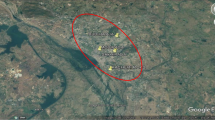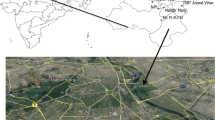Abstract
The PM2.5 and PM10 samples were collected during Diwali celebration from study area and characterized for ionic concentration of four anions (NO3 −, NO2 −, Cl−, SO4 2−) and five cations (K+, Mg2+, NH4 +, Ca2+, Na+). The results showed that the ionic concentrations were three times compared to those on pre and post Diwali days. Predominant ions for PM2.5 were K+ 33.7 μg/m3, Mg+ 31.6 μg/m3, SO4 2− 22.1 μg/m3, NH4 + 17.5 μg/m3 and NO3 − 18 μg/m3 and for PM10 the ionic concentrations were Mg+ 29.6 μg/m3, K+ 26 μg/m3, SO4 2− 19.9 μg/m3, NH4 + 16.8 μg/m3 and NO3 − 16 μg/m3. While concentration of SO2 and NO2 were 17.23, 70.33 μg/m3 respectively.

Similar content being viewed by others
References
Attri AK, Kumar U, Jain VK (2001) Formation of ozone by fireworks. Nature 411:1015
Bach W, Daniels A, Dickinson L, Hertlein F, Morrow J, Margolis S, Dinh V (1975) Fireworks pollution and health. J Environ Stud 7:183–192
Drewnick F, Hings SS, Cutius J, Eerdekens G, Williams J (2006) Measurement of fine particulate matter and gas-phasespecies during the new year’s fireworks 2005 in Mainz Germany. Atmos Environ 40:4316–4327
Hirai K, Yamazaki Y, Okada K, Furuta S, Kubo K (2000) Acute eosinophilic pneumonia associated with smoke from fireworks. Intern Med (Japan) 39:401–403
Ion Chromatography Analysis of Ambient Air Particulate Matter (2003) Standard operating procedure (SOP), (DEQ03-LAB-0029-SOP) Version 2.1
Kulshrestha UC, Nageswara Rao T, Azhaguvel S, Kulshrestha MJ (2004) Emissions and accumulation of metals in the atmosphere due to crackers and sparkles during Diwali festival in India. Atmos Environ 38:4421–4425
Liu DY, Rutherford D, Kinsey M, Prather KA (1997) Real time monitoring of pyrotechnically derived aerosol particles in the troposphere. Anal Chem 69:1808–1814
Moreno T, Querol X, Alastuey A, Minguillon MC, Pey J, Rodriguez S, Miro JV, Felis C, Gibbons W (2007) Recreational atmospheric pollution episodes: inhalable metallic-ferrous particles from fireworks displays. Atmos Environ 41:913–922
Ravindra K, Mor S, Kaushik CP (2003) Short-term variation in air quality associated with fireworks events: a case study. J Environ Monit 5:260–264
Wang Y, Zhuang G, Xu C, An Z (2007) The air pollution is caused by the burning of fireworks during the lantern festival in Beijing. Atmos Environ 41:417–431
Acknowledgments
The authors are grateful to Director, National Environmental Engineering Research Institute, Nehru Marg, Nagpur—440020, India, for providing encouragement and facilities to carry out this work and for permission to publish these findings.
Author information
Authors and Affiliations
Corresponding author
Rights and permissions
About this article
Cite this article
Rao, P.S., Gajghate, D.G., Gavane, A.G. et al. Air Quality Status During Diwali Festival of India: A Case Study. Bull Environ Contam Toxicol 89, 376–379 (2012). https://doi.org/10.1007/s00128-012-0669-9
Received:
Accepted:
Published:
Issue Date:
DOI: https://doi.org/10.1007/s00128-012-0669-9




